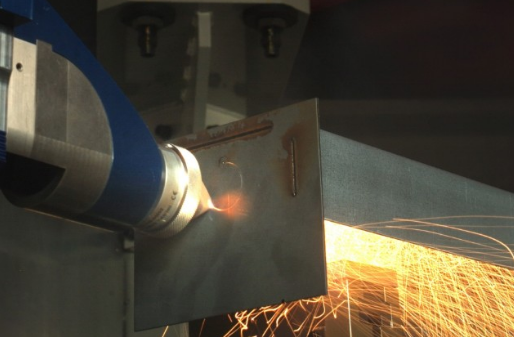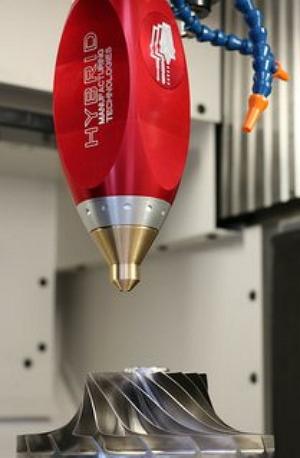Born out of the rise of the first computer systems at the end of World War Two, computer numerical control (CNC) machining has become a crucial tool in the world of manufacturing for its ability to fabricate parts from solid material in a highly automated fashion. Whether it be wood, plastic, metal, ceramic or a composite, CNC machines can drill, bore or cut their way to precise components.
If it weren’t for CNC machines, 3DPrint.com nor this author would not be where we are today. Some early 3D printers (and some modern models) were made by retrofitting print heads onto CNC machines. Most additive manufacturing (AM) systems are designed using similar machine architecture and tool path code as are found in CNC equipment.
It is in part these technologies’ shared histories that led to the evolution of hybrid manufacturing, in which CNC and AM operations are performed within the same build chamber. While still a somewhat niche technology, hybrid manufacturing is growing in terms of companies involved in the sector, as well as its adoption and impact. In this series, we will explore the variety of hybrid manufacturing processes on the market, the firms involved in the space, and some of the technology’s applications.
Pros and Cons of Additive and Subtractive Manufacturing
CNC machining can be a costly, time-consuming process that results in excessive and expensive waste, particularly in the case of metals. In the process of making a somewhat limited run of parts, piles of metal shavings are more likely to end up in scrap than remade as something useful. Moreover, CNC operations cannot achieve complex geometries.
AM is capable of overcoming some of the hurdles faced by CNC machining. Complex geometries are not an issue in most 3D printing processes, and material waste is minimal. Yet, metal 3D printing requires extensive post-processing, including the smoothing of rough surface finish and the removal of support structures.
Also important is the fact that CNC parts are much stronger than 3D-printed ones. Whereas CNC creates objects by cutting away from a solid block, AM fuses layers together, a bond that is significantly weaker. Additionally, AM parts exhibit porosity that can further reduce strength.
Hybrid manufacturing seeks to combine the benefits of each technology, either building up a metal blank from scratch using a variety of AM and then CNC machining the final shape or cutting away a block of metal to the desired shape using CNC and then adding necessary features with AM. If you want to be schmaltzy about it, AM is the yin to subtractive manufacturing’s yang.
Hybrid Manufacturing Types
Most hybrid manufacturing systems rely on some form of directed energy deposition (DED) for the additive portion of a build. Developed out of earlier laser cladding for coating applications, DED involves the introduction of a metal material, such as a powder or wire, to an energy source, like a laser, electron beam or plasma arc.
Research into the integration of directed energy deposition technology into machining centers, either within the same machine cell or in adjacent cells, began in the mid to late 1990s. In 1996, Fraunhofer Institute of Production Technology & Fraunhofer Institute of Laser Technology performed research on a technology it dubbed Combined Metal Build Up while, around the same time, the University of Missouri worked on its Laser Aided Manufacturing Process.
Sometimes classified alongside DED, wire-arc additive manufacturing (WAAM) is an evolution of wire arc welding in which a metal wire is heated by an electric arc welding torch to fabricate parts layer by layer. Some WAAM machines are capable of making parts up to 42 meters long.
That isn’t to say that there aren’t other forms of metal 3D printing that have been used in hybrid systems. The first commercially available hybrid system was released in Japan in the late 1990s, combining laser powder bed fusion (PBF) with a vertical machining center. That machine has evolved to become the LUMEX Avance-25 by Matsuura. This technology uses a high-powered laser to print the way a traditional metal PBF printer would, except that, after .5 mm have been printed, a CNC mill smooths our the finish.
That said, there are not many PBF hybrid systems on the market, in particular because cutting fluids and other debris can interfere with the additive portion of the equipment. Also, unlike DED and WAAM, PBF is less suited for repairing existing parts. PBF is so far unable to combine disparate metals the way that DED can.
Similarly, there are fewer hybrid systems for polymers. Most are low-cost extrusion 3D printers with swappable tool heads for laser engraving or milling. There are important large-scale exceptions. Though hybrid polymer printers are not as prevalent, we will cover them in an upcoming section of this series.
In addition to these processes, there are other hybrid technologies that don’t exactly fit into the typical image of hybrid manufacturing, such as ultrasonic AM from Fabrisonic. UAM uses ultrasonic welding to meld layers of metal foils before a CNC head cuts out the final shape of the object.
Hybrid manufacturing is available via standalone systems or through add-on modules or tool heads. In the first case, machines are just as they sound, a dedicated system with built-in additive and subtractive capabilities. In the latter case, CNC owners can purchase a module or tool head to be integrated into their existing CNC machines. In most cases, DED is combined with some variation of subtractive tool head, usually a high-powered laser or milling end. Most frequently, multi-axis milling centers are used as the basic platform for hybrid manufacturing.
In the next section of this series, we will go into greater detail about the systems described year as we explore the various companies in the space.
Join the discussion of this and other 3D printing topics at 3DPrintBoard.com.
Subscribe to Our Email Newsletter
Stay up-to-date on all the latest news from the 3D printing industry and receive information and offers from third party vendors.
You May Also Like
Further Understanding of 3D Printing Design at ADDITIV Design World
ADDITIV is back once again! This time, the virtual platform for additive manufacturing will be holding the first-ever edition of ADDITIV Design World on May 23rd from 9:00 AM –...
3D Printer Maker EVO-tech Reborn as NEVO3D — Once More With Feeling
EVO-tech was a 3D printing service and original equipment manufacturer established in 2013 and based in Schörfling am Attersee, Austria. The company produced high-quality material extrusion systems featuring linear bearings,...
3D Systems Brings 3D Printed PEEK Cranial Implant to the U.S. with FDA Clearance
For more than 10 years, 3D Systems (NYSE:DDD) has worked hand-in-hand with surgeons to plan over 150,000 patient-specific cases, and develop more than two million instruments and implants from its...
CDFAM Returns to Berlin for Second Annual Symposium
The second CDFAM Computational Design Symposium is scheduled for May 7-8, 2024, in Berlin, and will convene leading experts in computational design across all scales. Building upon the first event...

































